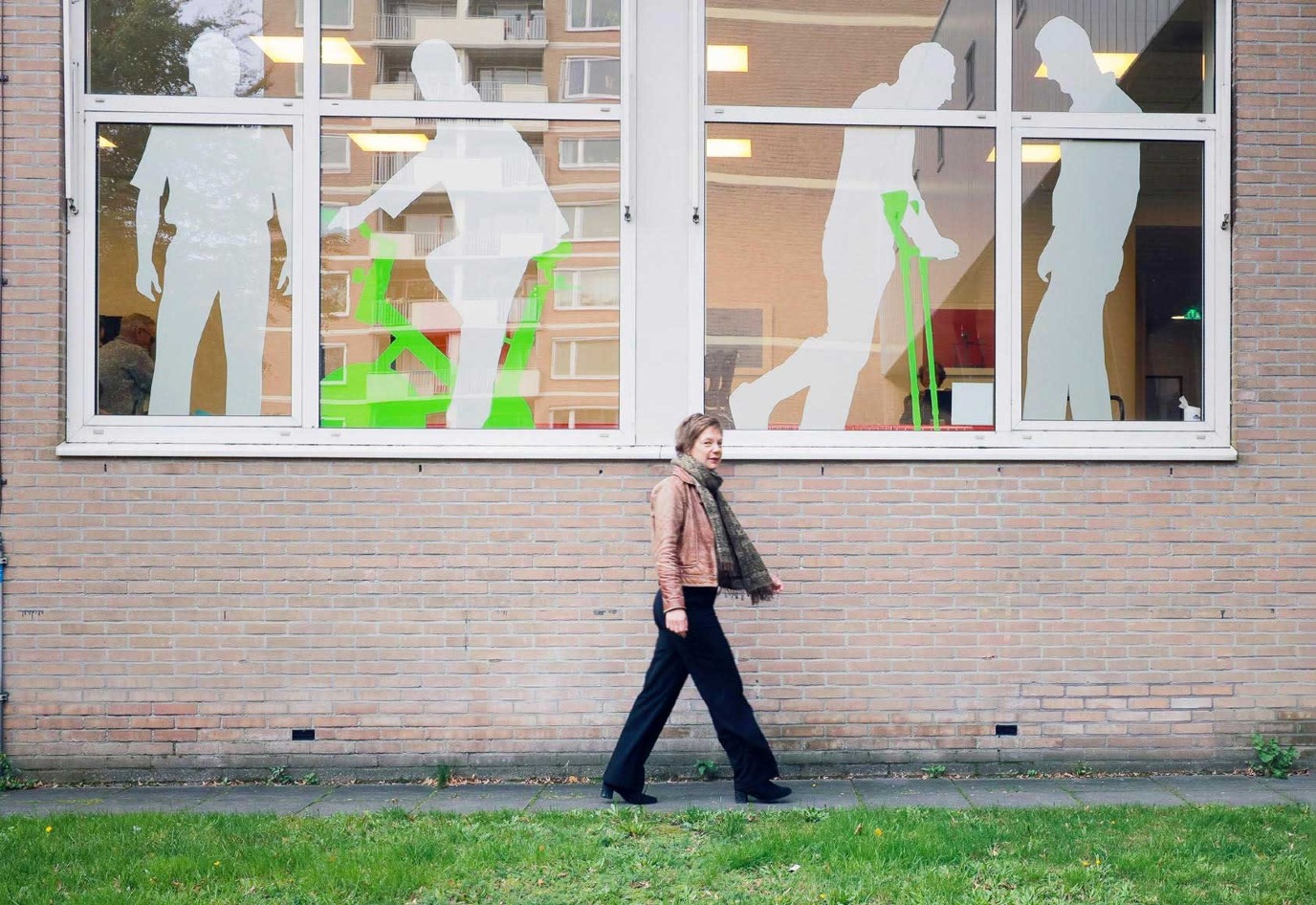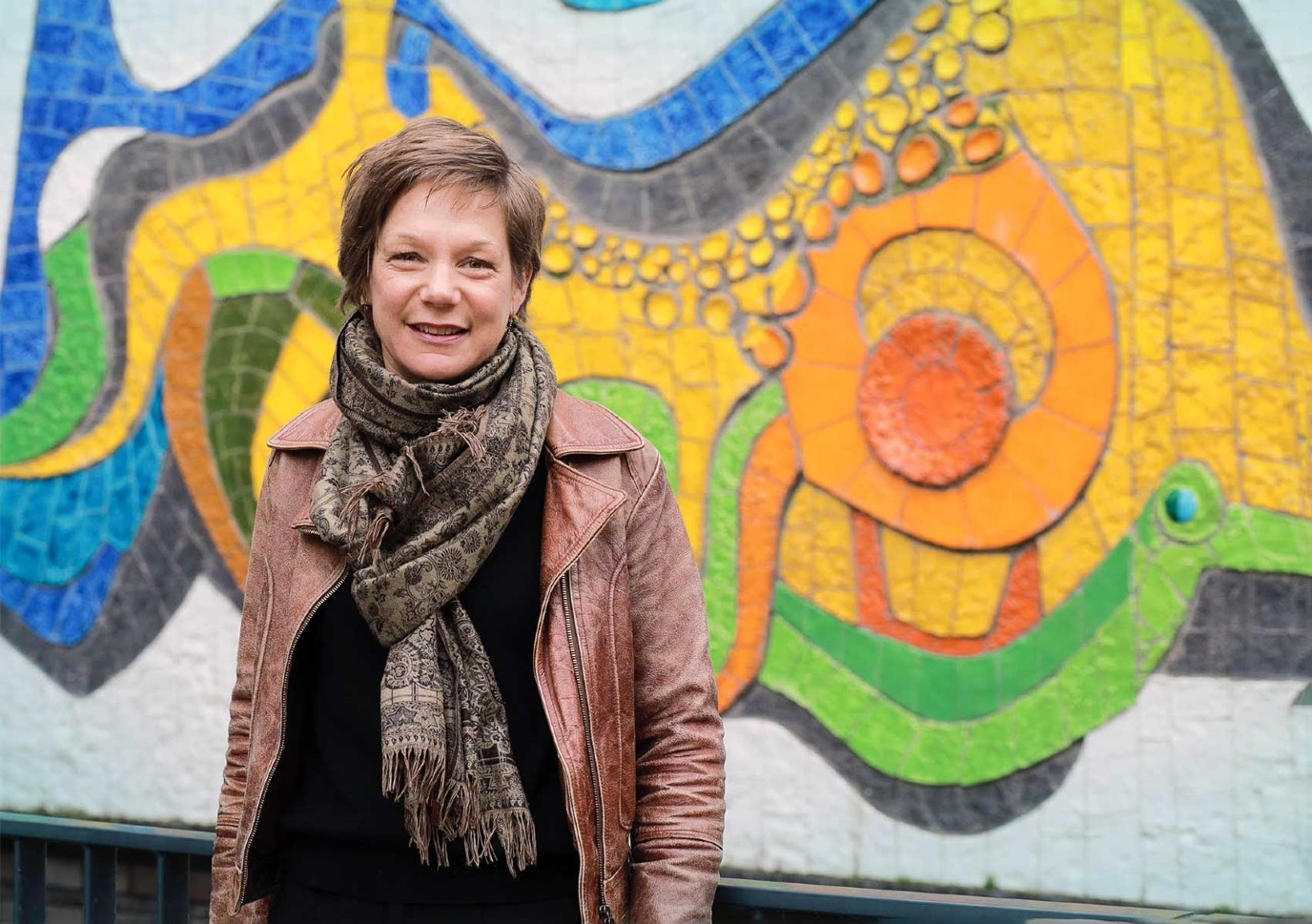Ruimte om gelukkig oud te worden

Louise Meijering, hoogleraar in de gezondheidsgeografie, heeft net haar oratie achter de rug. Er staat nog een doos met boekjes in haar kantoor. Op de voorkant prijken naast de titel ‘Ruimte voor gezondheid’ afbeeldingen van houten huisjes en boompjes. Toepasselijk, want het verhaal dat ze wil vertellen gaat over het vormgeven van duurzame gemeenschappen in een vergrijzende samenleving. “Er is winst te halen in het eenvoudiger maken van de regelgeving. Vooral voor mensen in een kwetsbare positie.”
Tekst: Merel Weijer, afdeling Corporate Communicatie / Foto's: Henk Veenstra
Te theoretisch
De weg naar het moment van de oratie was een met omwegen. In 2006 promoveerde ze als cultureel geograaf, maar stopte daarna meteen weer met de wetenschap. “Het was allemaal wat te theoretisch en ik miste de maatschappelijke relevantie.” Ze dook vervolgens de praktijk in door vrijwilligerswerk in Afrika te gaan doen, verhuisde naar Zweden en ging toen ze terug was in Nederland aan de slag bij een netwerkorganisatie voor ruimtelijke ordening. Het werk was leuk maar ze miste de inhoud. In 2009 keerde ze weer terug op haar oude nest. Ze was een aantal jaren universitair docent, tot ze besloot haar wetenschappelijke carrière meer te focussen. “Dus, een duidelijk plan maken, onderzoeksgeld binnenhalen, veel projecten doen en daarover publiceren.” Het gaat haar allemaal goed af. Als kers op de taart werd ze in 2020 ook nog benoemd op een Aletta Jacobsleerstoel.
Thuis in de buurt
Nu zit ze echt op haar plek. Als gezondheidsgeograaf doet ze onderzoek naar de relatie tussen het welbevinden van mensen en de omgeving waarin men leeft. Hoe voelt een mens zich thuis in huis en in de buurt? Ze vindt vooral groepen mensen die niet zoveel vertegenwoordigd zijn in onderzoek interessant. Ouderen met een beperking, maar ook migranten en mensen in langdurige armoede. Groepen waarvoor het een uitdaging is om een optimale leefomgeving te hebben. Ze onderzoekt het samenspel tussen de fysieke omgeving (je huis, je buurt) en de sociale omgeving, de mensen. Met wie woon je, wie krijg je op bezoek, hoe voel je je in de buurt.

Duurzame leefgemeenschappen
Met de vergrijzing en de ouderenzorg die onder druk staat is dit een actueel maar ook ingewikkeld vraagstuk. Hoe richt je een buurt in zodat er een netwerk ontstaat waarin mensen zich thuis voelen en elkaar helpen. Hier is volgens Meijering nog wel een verandering in nodig. Gemeenschappen moeten anders ingericht worden. “In een buurt waar bijvoorbeeld alleen drukke tweeverdieners met kinderen wonen is weinig tijd en ruimte voor zorg aan anderen dan de naaste omgeving. Er moeten duurzame, toekomstbestendige leefgemeenschappen ontstaan waar men gelukkig oud kan worden, waar jongeren kunnen werken en waar gezinnen kunnen wonen. “
Eerder nadenken over de toekomst
Toch ziet Meijering dat er geen pasklare oplossing is. Er is volgens haar winst te halen als men op tijd begint met nadenken over hoe het moet als je ouder wordt. Veel mensen beginnen hier pas mee als het al te laat is en er acuut naar een oplossing gezocht moet worden. Verder is het ook belangrijk dat er dan wel plekken zijn waar mensen naar toe kunnen en willen. Dat wordt nu niet centraal geregeld, maar door veel verschillende instanties. Er zijn gelukkig wel voorbeelden waar iets moois ontstaat. Meijering noemt een project in Vledder waar een zorgcoöperatie is opgericht. Het dorp heeft zelf een voorziening voor ouderen laten bouwen zodat ze in het dorp kunnen blijven wonen. Daarnaast kunnen de jongeren werken in het zorgcentrum en is de kans groter dat ze niet vertrekken uit het dorp. Meijering vindt het interessant om naar de succesfactoren van dit soort initiatieven te kijken om te zien of je dit dan ook op meer plekken zou kunnen doen. Volgens haar ligt hier ook een taak voor de overheid en woningcoöperaties. “Er is winst te halen in het eenvoudiger maken van de regelgeving. Vooral voor mensen in een kwetsbare positie.”
Zorg zonder regels
Dat het eenvoudiger kan zag ze zelf van dichtbij. Meijering was in het begin van haar carrière betrokken bij een onderzoek binnen een organisatie voor ouderenzorg. Zorgmedewerkers hadden daar het gevoel dat hen door verzekeraars en zorgkantoren, allerlei regels werden opgelegd waar ze aan moesten voldoen waardoor ze de hele dag alleen maar formulieren aan het invullen waren en niet meer toekwamen aan echte zorg. Interessant was dat ze er tijdens het onderzoek achter kwamen dat ze een deel van de regels ook zelf bedacht hadden. Ze legden zichzelf regels op doordat ze steeds verantwoording moesten afleggen en daardoor risico’s probeerden te beperken. Het bewust worden hiervan heeft ze geholpen. “Ze zijn heel goed gaan kijken naar wat ze konden loslaten aan regels en vooral ook naar wat willen mensen zelf nou graag en hoe kunnen ze dat mogelijk maken. En dat hoeft uiteindelijk niet heel ingewikkeld te zijn.”

Elkaar begrijpen
Als geograaf kijkt Meijering naar plekken. Hoe kan je in een verpleeghuis ook een thuis realiseren, of hoe kun je de buurt als plek fysiek en sociaal zo goed mogelijk inrichten. Ze werkt hierbij graag samen met mensen uit andere disciplines zoals de geneeskunde, architectuur, ergotherapie, planologie en bewegingswetenschappers. “Iedereen kijkt vanuit zijn eigen perspectief naar het probleem, maar als je elkaar goed kunt begrijpen kun je echt een bijdrage leveren aan het vinden van een oplossing.” Daarom is volgens haar interdisciplinair onderzoek zo belangrijk. “Het is de beste manier om een ingewikkeld vraagstuk zoals ’hoe kun je de ouderenzorg beter maken’, aan te pakken. Dat kan alleen door verschillende disciplines goed met elkaar te laten samenwerken.”
Terug bij de theorie
Ondanks het feit dat ze nu veel met mensen uit de praktijk samenwerkt blijft ze toch een echte wetenschapper. Dat ziet ze als ze met mensen samenwerkt uit het werkveld zoals gemeentes of zorginstellingen. Ze stelt veel vragen. Bijvoorbeeld hoe iets werkt of wat iets betekent. En zo is ze toch uiteindelijk op haar plek in iets wat ze eerst afwees als ‘te theoretisch’. De theorie, het onderzoek doen en publiceren is belangrijk voor haar. Maar dat er ook echt iets gebeurt met de resultaten, nadat het in een Engelstalig peer review tijdschrift heeft gestaan, vindt Meijering even belangrijk. Daarin ligt de uitdaging. En zo heeft ze een waardevolle combinatie te pakken in haar werk.
Toch blijft ze naast het onderzoekswerk ook altijd met veel plezier onderwijs geven en studenten begeleiden. Daar ligt volgens haar eigenlijk de grootste maatschappelijk impact die je als wetenschapper kunt hebben. Het opleiden van jonge mensen zodat ze complexe vraagstukken beter begrijpen en vervolgens ook hun eigen bijdrage kunnen leveren.
Meer informatie
Meer nieuws
-
01 december 2025
De kracht van beweging
-
24 november 2025
RUG en Ministerie van I&W starten brede meerjarige samenwerking
